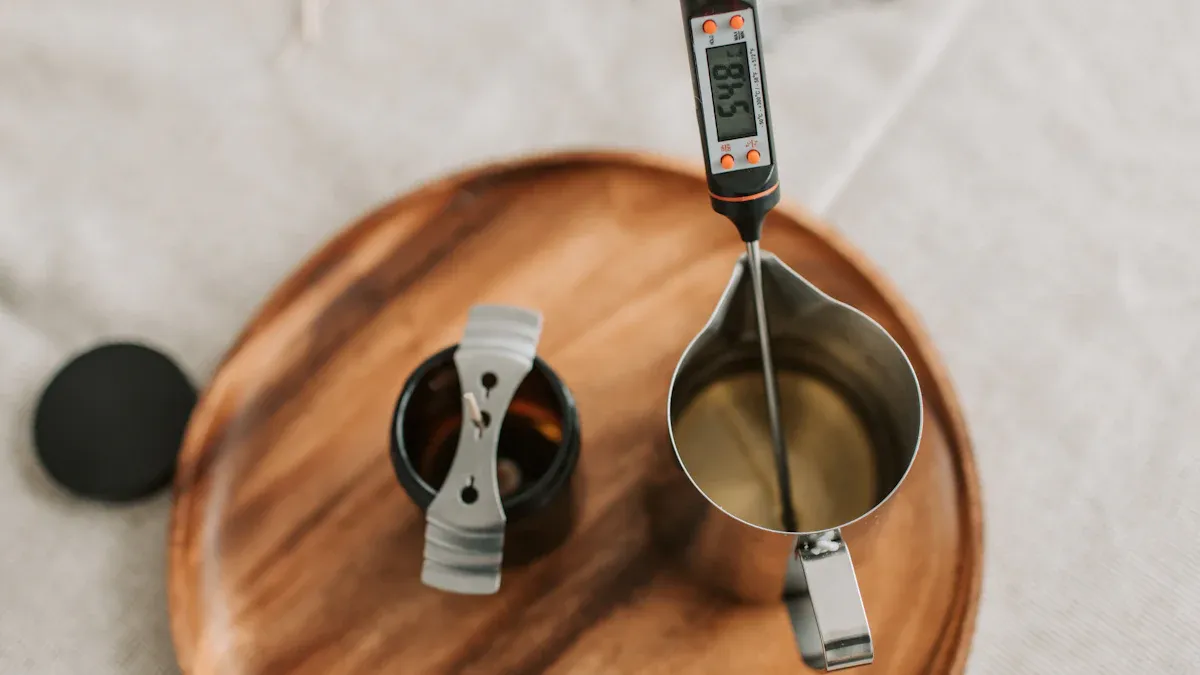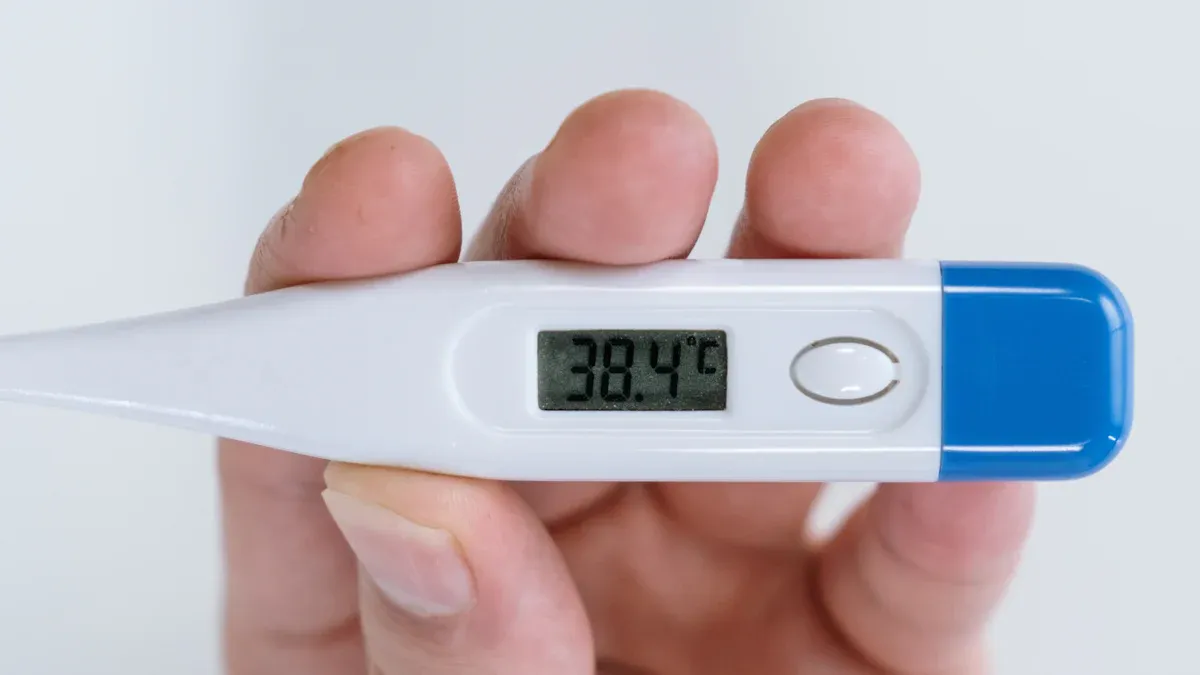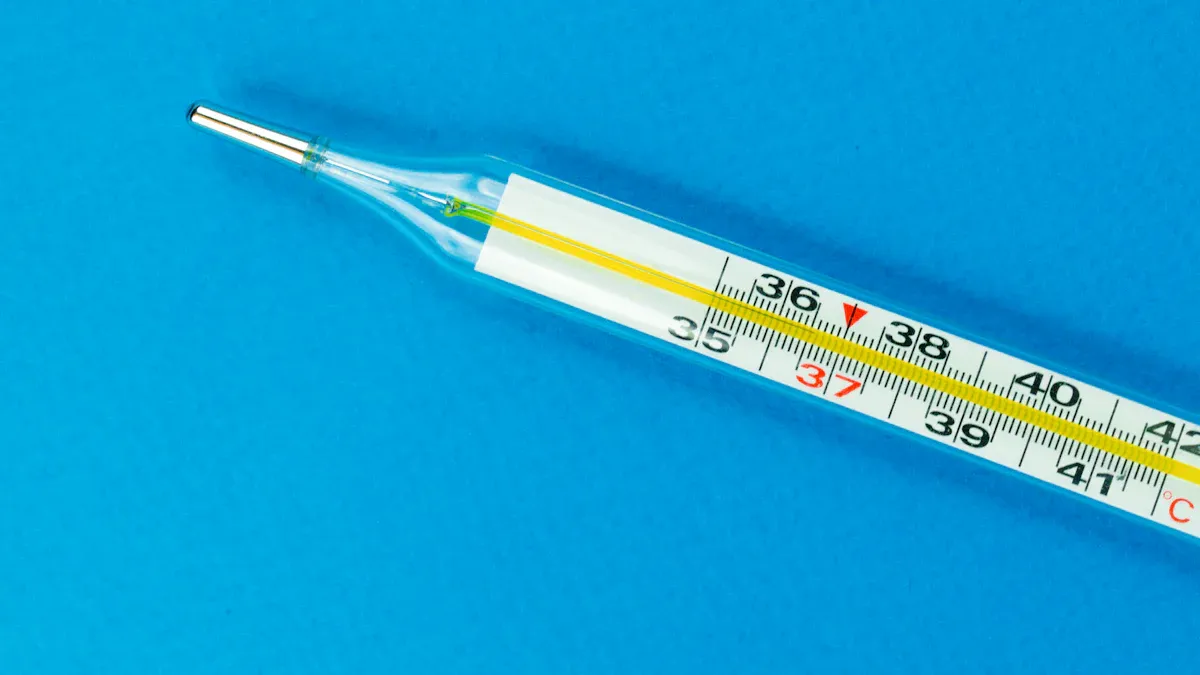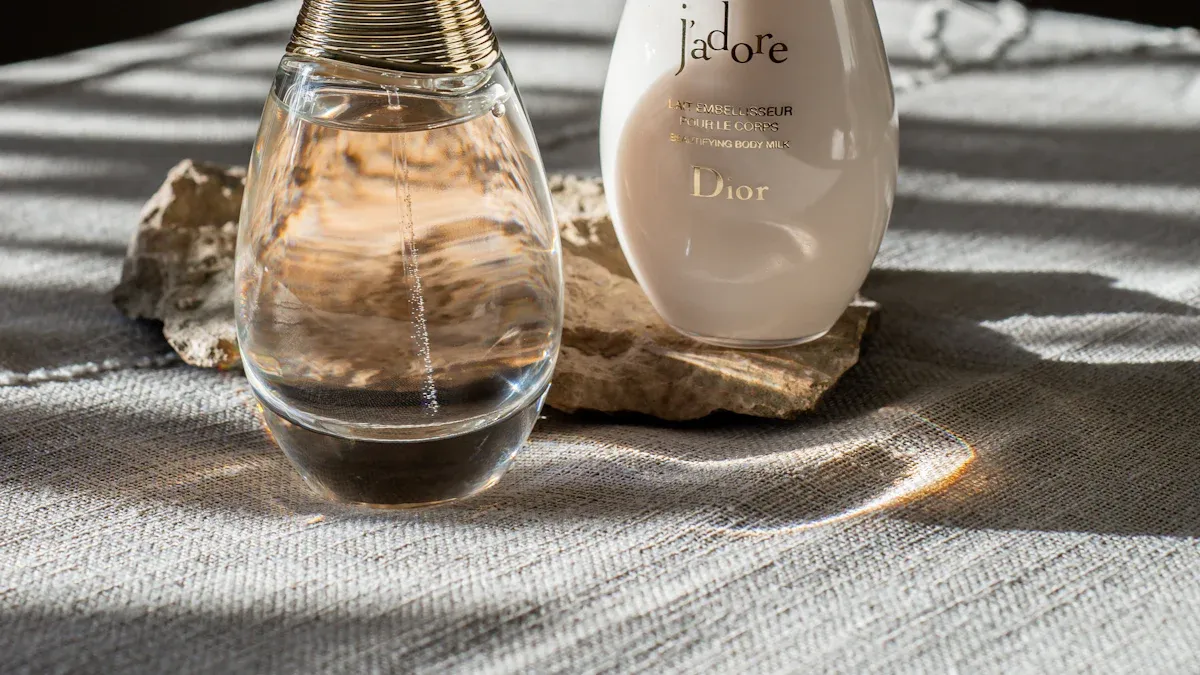
Have you ever thought about why thermometers need checking? Let me tell you. Thermometers be calibrated to make sure their readings are correct. This is very important when we use them for serious tasks, like cooking, healthcare, or making products.
How often should you check them? It varies. Some things to think about are how much you use it, the kind of thermometer, and where it’s used. For example:
Tools used every day might need checking every month.
Ones in extreme heat or cold should be checked right after.
In places like medicine factories, exact temperatures are super important. Without this, problems could cost a lot of money or cause danger. So, whether it’s for your kitchen or a lab, regular checks keep them accurate and help avoid problems.
Why Thermometers Be Calibrated
Ensuring Accurate Measurements
Accurate measurements are the backbone of any thermometer’s purpose. If they’re wrong, how can we trust them? Calibration is like a check-up for your thermometer. It makes sure the thermometer gives correct readings by comparing it to a trusted standard. For example, in food safety, thermometers must be exact to keep food safe. Some thermometers need daily checks, while others last longer. Advanced ones may need experts to keep them accurate.
Did you know calibration helps industries follow strict rules? Groups like the FDA and WHO stress having calibrated thermometers in healthcare and cold storage. This keeps products safe and meets global rules. Whether you’re cooking or shipping vaccines, calibration keeps things working right.
Preventing Errors in Critical Applications
Errors in critical applications can lead to serious consequences. Imagine using a thermometer that’s not checked in a factory. I read about a case where a steam reformer had a 24-degree Celsius error. That’s a big issue! It caused problems that could’ve been avoided with regular checks.
In healthcare, factories, or even at home, errors waste time, money, and safety. Calibration makes sure thermometers give correct data. This helps people make good decisions. It’s like having a reliable friend who always tells the truth.
Extending the Lifespan of the Thermometer
Calibration doesn’t just ensure accuracy—it also extends the life of your thermometer. Over time, thermometers can become less reliable. Regular checks catch small problems early. This stops bigger issues, like broken equipment.
I’ve noticed calibrated thermometers last longer because they’re cared for. It’s like getting your car tuned up often. You fix small issues before they get worse. Plus, a well-kept thermometer works better, giving you confidence every time you use it.
How Often Should a Food Thermometer Be Calibrated
Before First Use
Always calibrate a food thermometer before using it for the first time. New thermometers might not be perfectly accurate right away. Manufacturing can sometimes cause small errors in readings. Calibrating ensures your thermometer gives correct measurements from the start.
It’s like trying out new shoes. You wouldn’t wear them on a long hike without checking the fit first. The same goes for your thermometer. Whether you’re checking food temperature or your fridge, calibration helps you start off right.
Tip: Most thermometers come with calibration instructions. Follow them carefully to avoid mistakes.
Monthly or Regularly Based on Usage
How often should you calibrate a food thermometer if used often? It depends on how much and where you use it. In busy kitchens, calibrate before each shift. At home, calibrating once a month or every few weeks works well.
Here’s a simple guide:
Bimetal thermometers: Check before each use or shift.
Digital thermometers: Calibrate weekly or monthly, depending on use.
HACCP rules: Keep accuracy within 2°F for food safety.
Frequent calibration isn’t just about being exact. It also gives peace of mind. A reliable thermometer means safe and tasty food every time.
Fun Fact: Thermometers measuring extreme temperatures may need more checks. Bigger ranges can make them drift faster.
After Dropping or Physical Impact
If your thermometer falls, calibrate it right away. Drops can mess up its parts, causing wrong readings. Even small impacts can lead to big errors, especially for digital thermometers.
Here’s what happens:
Drops can make thermometers lose their accuracy.
Extreme heat or cold can also affect how they work.
Calibration after accidents keeps them dependable.
Skipping this step can cause problems, especially in food safety. Wrong readings might lead to undercooked food, which can make people sick. For businesses, this could mean losing money or facing legal issues. A quick calibration after a drop avoids these troubles.
Pro Tip: Keep your thermometer in a case to protect it from damage.
After Exposure to Extreme Temperatures
Thermometers in extreme temperatures need quick calibration. Why is this important? Big temperature changes can make them inaccurate. I once used my food thermometer for a roast, then left it in the freezer. It stopped giving correct readings until I fixed it.
Hot or cold extremes can harm thermometer parts. For instance, checking boiling water and then ice water without fixing it can cause errors. Digital thermometers are especially sensitive to these changes.
Here’s what you should do:
Calibrate after extreme use. If your thermometer faces very hot or cold conditions, check it.
Try easy methods like the ice water test. It’s simple and helps your thermometer work properly again.
Pro Tip: Store your thermometer in a steady place. Don’t leave it near stoves or in freezers where temperatures change a lot.
Fixing your thermometer after extreme conditions keeps it accurate. It’s worth the small effort to keep it ready to use.
Following Manufacturer Guidelines
Manufacturer guidelines help keep your thermometer accurate. Each thermometer is unique, and the manual shows how to calibrate it. I always read the manual for new thermometers—it’s like a guide for perfect use.
Here’s what most manuals suggest:
Before each use: Professional kitchens often check thermometers before using them.
Once a month: Regular users should calibrate monthly to keep it reliable.
After impacts or extreme use: Dropping or using it in tough conditions means it needs fixing.
Follow specific steps: Some thermometers need special methods, so check the manual.
Note: Lost your manual? Many companies have online copies. A quick search can help you find it.
By following these tips, your thermometer stays accurate and lasts longer. Think of it as giving it care to keep it working well.
Methods to Calibrate Thermometers

Keeping thermometers accurate is important. There are simple ways to do this. Let’s look at three easy methods. You can try these at home or work.
Ice Water Method
The ice water method is a quick and simple way to check your thermometer. It doesn’t need special tools and works well for food thermometers. Follow these steps:
Fill a glass with crushed ice and cold water.
Stir for 30 seconds to even out the temperature.
Put the thermometer’s tip in the ice water. Don’t let it touch the glass sides or bottom.
Wait until the number stops changing. It should say 32°F (0°C).
If it doesn’t show 32°F, adjust it using the instructions from the maker. This method is great for checking cold items like drinks or salads.
Tip: Use clean ice and water to keep everything safe, especially in kitchens.
Boiling Point Method
The boiling point method is great for checking thermometers used in hot settings. It’s helpful when cooking soups or frying food. Here’s how to do it:
Heat a pot of water until it boils.
Put the thermometer’s tip in the boiling water. Keep it away from the pot’s sides and bottom.
Wait for the number to stop moving. It should read 212°F (100°C) at sea level.
Remember, water boils at lower temperatures in high places. Check your area’s boiling point if you live at a high altitude.
Pro Tip: Use this method for thermometers that measure high heat, like candy or frying thermometers. It’s perfect for making caramel or fried chicken!
Using a Reference Thermometer
A reference thermometer is the most accurate way to calibrate. It’s ideal for places like labs or hospitals where precision matters. Here’s how it works:
Put the thermometer you’re testing and the reference thermometer in the same spot.
Compare their numbers at different temperatures, like freezing or boiling.
Adjust the tested thermometer to match the reference one.
This method gives the best accuracy. Experts often use reference thermometers for devices like ear or no-touch thermometers. They’re essential in industries where small mistakes can cause big problems.
Note: Reference thermometers are checked by professionals and follow strict rules. Use them if you need perfect accuracy.
Each method has its benefits. For everyday tasks, the ice water and boiling point methods are fast and easy. For critical jobs, a reference thermometer is the best choice. No matter the method, keeping your thermometer accurate ensures reliable results every time.
Professional Calibration Services
Professional calibration services help thermometers stay correct and dependable. While simple tests like the ice water method are useful, experts go further. They use special tools to adjust thermometers for important jobs.
I’ve noticed how these services improve accuracy, especially in fields like healthcare or factories. They don’t just fix mistakes—they stop them before they happen. Here’s why expert calibration matters:
🛠️ Improved Accuracy: Professionals use advanced tools to make thermometers highly precise. This is crucial for tasks like medicine or food safety.
💰 Saving Money: Proper calibration avoids costly errors and product recalls. It also stops wasting money on wrong product approvals or rejections.
🌍 Meeting Global Rules: Expert calibration helps industries follow strict international standards. This is key for fields like science or manufacturing.
Tip: If you use thermometers for work or critical tasks, hiring experts is a smart choice. It keeps your tools working well and lasting longer.
Studies show calibration increases profits by ensuring high-quality products. Customers trust businesses that deliver reliable results, which builds loyalty. Plus, calibrated thermometers break less often, saving money on repairs or replacements.
When should you call professionals? If your thermometer is used for important tasks or seems worn out, it’s time. Experts compare it to trusted standards and make fixes you can’t do yourself.
Note: Many services provide certificates proving your thermometer meets industry rules. This is helpful for businesses needing to follow regulations.
Professional calibration isn’t just about fixing tools—it’s about achieving success. Whether you run a kitchen, lab, or factory, accurate thermometers make a big difference.
Signs a Thermometer Needs Calibration

Inconsistent or Erratic Readings
Inconsistent readings mean your thermometer might need calibration. If the numbers change too much or seem wrong, check its accuracy. I’ve noticed this when checking food—it’s hot one moment, cold the next.
Many things can cause these changes, like timing or health. Here’s a simple table:
Cause | What It Means |
|---|---|
Timing Issues | Measuring at different times can change results. |
Lifestyle Factors | Things like illness or medicine can affect readings. |
Saw-tooth Pattern | May show body energy or health problems. |
Saddle Pattern | A drop then rise in temperature, possibly from hormones. |
If you see these issues, recalibrate your thermometer. Wrong readings can cause mistakes, especially in cooking or healthcare.
Physical Damage or Wear
Damage is another sign your thermometer needs fixing. Dropping it or hitting it can break parts inside, making it wrong. I dropped mine once, and it stopped working right.
Here’s what damage can do:
🛠️ Move parts inside, causing errors.
🛠️ Make readings wrong because of broken pieces.
If your thermometer looks old or damaged, don’t ignore it. Regular checks can find problems early and keep it working well.
Unusual Results in Routine Testing
Strange results during tests mean it’s time to recalibrate. I always compare my thermometer to a trusted one. If they don’t match, something’s off.
Here’s what to do during checks:
✅ Fix it right away if it’s not accurate.
✅ Decide if it’s still safe to use if it can’t be fixed.
✅ Check for safety or quality problems if calibration fails.
For very accurate thermometers, test them with ice water often. Special thermometers, like platinum ones, need yearly checks. These steps keep your thermometer reliable, whether at home or in a lab.
Long Periods of Inactivity
Did you know thermometers can become less accurate if unused? It’s true! When left idle for weeks, parts inside may shift. This can cause wrong readings when you use it again.
Here’s why checking after inactivity matters:
Internal Drift: Sensors may change from their original settings over time.
Environmental Factors: Humidity, dust, or temperature changes can affect stored thermometers.
Battery Issues: Weak batteries in digital thermometers can lead to errors.
Tip: Store your thermometer in a clean, dry spot to avoid problems.
Once, I used my food thermometer after a long break. It gave strange readings. I tested it with the ice water method and found it was off. A quick calibration fixed it. This showed me how important regular checks are, even for unused thermometers.
If your thermometer hasn’t been used:
Test it first. Use the ice water or boiling point method to check it.
Change the battery. A new battery helps digital thermometers work better.
Check for damage. Look for cracks, rust, or other issues.
Pro Tip: Unsure about accuracy? Professional calibration services can make it like new.
Keeping your thermometer accurate after breaks is simple. Small steps ensure it works well every time!
Do New Thermometers Require Calibration
Why New Thermometers May Require Calibration
Yes, new thermometers may require calibration. Even though they are often pre-calibrated, they might not be perfect. I’ve seen digital thermometers give wrong readings straight out of the box. It’s annoying when you expect them to work right but they don’t.
Here’s why calibration is important:
🛠️ Factory settings can have small mistakes: Manufacturing isn’t always exact.
📜 Keeping records helps: Calibration certificates track problems over time.
⚠️ Critical uses need checks: For food safety or healthcare, accuracy is key.
Calibration makes sure your thermometer works well in real-life situations, like checking food or medical temperatures.
Manufacturer Pre-Calibration vs. User Calibration
Pre-calibration by manufacturers isn’t always accurate in real use. I’ve noticed thermometers act differently depending on where they’re used. For example, a thermometer set up in a factory might not work the same in a busy kitchen.
Here’s why this happens:
Issue Description | What It Means |
|---|---|
Inconsistent measurements | Readings can vary and be unreliable. |
Differences from reference thermometer | Results may not match trusted devices. |
Errors beyond stated accuracy | Some readings are outside expected range. |
Measurement error range | Errors can go from −3 to +2 °C. |
Real-world challenges | Everyday use increases chances of errors. |
These reasons show why user calibration matters. It’s like tuning a guitar—you adjust it to fit your needs.
Best Practices for First-Time Use
Always calibrate a new thermometer before using it. Think of it like trying on new shoes. You want to make sure it fits well before using it for something important.
Here’s what you should do:
🧊 Use the ice water method: It’s simple and checks cold readings.
🔥 Try boiling water: This tests if it works for hot temperatures.
📖 Follow the manual: Read the instructions for proper calibration.
🛡️ Store it safely: Keep it in a dry place to avoid damage.
These steps help your thermometer give accurate results from the start.
Checking thermometers regularly keeps them working correctly and dependably. If you skip this, the readings might be wrong. This can cause problems in important tasks like cooking or healthcare. I always check my thermometer based on how often I use it and the conditions it faces.
Here’s a simple table showing what affects how often to calibrate:
What Affects Calibration | What It Means |
|---|---|
Maker’s Instructions | Follow the brand’s rules. |
How Often You Use It | More use means more checks. |
Temperature Changes | Big changes can affect accuracy. |
Rules from Authorities | Some jobs require regular checks. |
Quality Standards | Meeting rules needs frequent calibration. |
For easy jobs, try the ice water or boiling water tests. For special thermometers, experts might need to check them. Even new thermometers can be off, so test them before using to make sure they’re ready.
A study found that calibrating handheld infrared thermometers makes them more reliable. This shows why it’s smart to check your thermometer often.
By doing this, your thermometer will last longer and work well when needed. Trust me, it’s worth the time!
FAQ
How do I know if my thermometer needs calibration?
Look for signs like strange readings or visible damage. If your thermometer shows odd numbers, has been dropped, or hasn’t been used for a while, it’s time to check it. Simple tests, like the ice water method, can help find problems early.
Tip: Test your thermometer after it’s been in very hot or cold places.
Can I calibrate all thermometers at home?
You can calibrate most thermometers at home with easy methods. Ice water and boiling water tests work well for food thermometers. But special thermometers, like those for medical or factory use, might need experts to fix them.
Pro Tip: Read your thermometer’s manual for exact calibration steps.
How often should I calibrate a digital thermometer?
Check digital thermometers every month or after heavy use. If you use it daily, test it more often. Dropping it or using it in extreme temperatures can make it less accurate, so recalibrate when needed.
Fun Fact: Digital thermometers are more delicate than bimetal ones, so handle them carefully.
What happens if I don’t calibrate my thermometer?
Wrong readings can cause big problems. For example:
🍗 Food that’s not cooked enough can make people sick.
🏭 Bad readings in factories can ruin products.
🩺 In healthcare, mistakes can put lives at risk.
Regular checks keep your thermometer safe and reliable.
Do I need special tools for calibration?
No, simple items like ice, water, and a pot work for most tests. For advanced thermometers, you might need a reference thermometer or expert help.
Note: Paying for professional calibration is smart for important jobs like healthcare or factory work.




